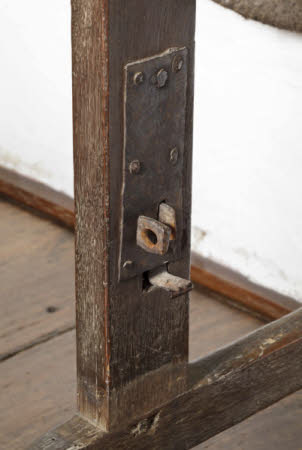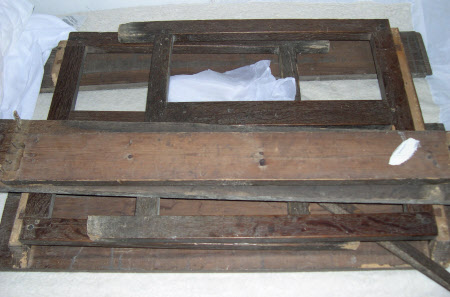Table
Category
Furniture
Date
1650 - 1750
Materials
Oak
Measurements
755 x 1040 x 663 mm
Place of origin
Cotehele
Order this imageCollection
Cotehele, Cornwall
NT 347839.1
Caption
This table was probably made on the Cotehele estate during the 17th century. It is one of seven similar tables in Cotehele House, of which only this one retains its original folding mechanism. It was illustrated by Peter Thornton in 'Seventeenth-Century Interior Decoration in England, France and Holland' (Yale University Press, 1981). Collectively, they are known as 'Spanish Tables', in the belief that the design was copied from folding tables salvaged from the wreckage of the Spanish Armada. Cotehele's tables may have been made for Colonel Piers Edgcumbe (1610-66) who took up residence here during the 1650s, and extensively remodelled the interior.
Summary
Table. One of seven similar tables with folding supports of plain design. Oak. This table was in an extremely broken condition prior to being conserved by intern Margriet Hage in 2010. The mechanism is illustrated in 'Seventeenth Century Interior Decoration in England, France and Holland' by Peter Thornton. (Yale University Press, 1981). It is the only table of the set that still has its folding mechanism in working order. According to Victor Chinnery (2004): An oak folding table, the four-plank top now lacking the original cleats, the underside fitted with two cross-battens to which are hinged a pair of open folding frames falling to form legs, to be held in position by angled wrought iron braces locating in spring-loaded catches fitted to the centre muntin of each frame. English, c.1650-1750
Provenance
According to Victor Chinnery (2004): Date of acquisition unknown, but recorded with others at Cotehele in Nicholas Condy’s views, c.1840. Illustrated by Peter Thornton in Seventeenth Century Interior Decoration in England, France & Holland, Yale University Press 1978 (p. 228, Fig. 212-3); A pine table of similar appearance, but very different folding action, is shown on same page, Fig. 214 (Gripsholm Castle, Sweden, made for Queen Hedvig Eleonora, pre 1715).



